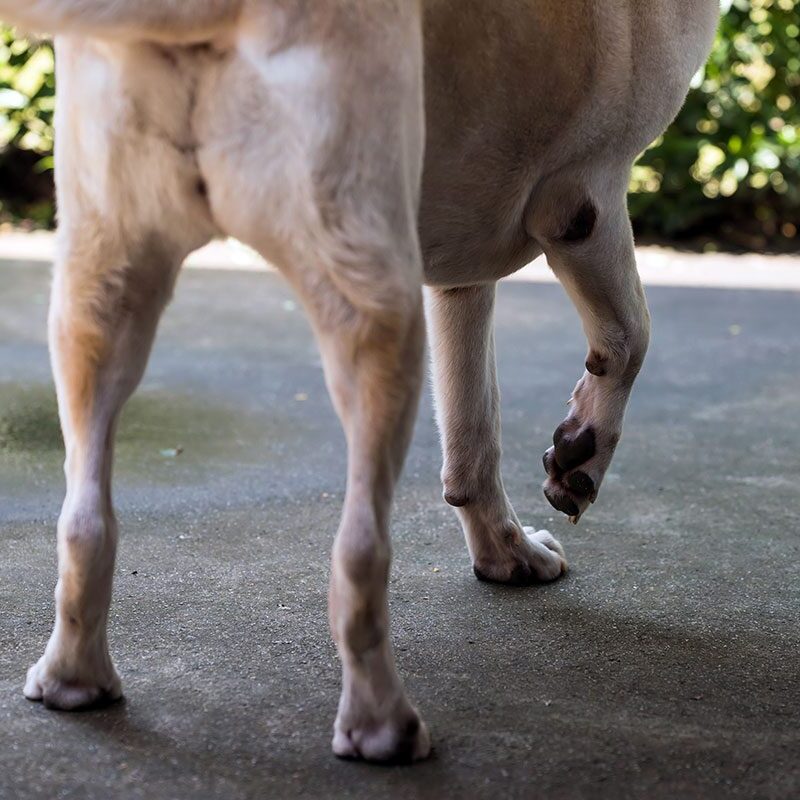
Osteochondritis dissecans (OCD) is a developmental orthopedic condition that affects the cartilage and bone within a dog’s joints. It occurs when the normal process of cartilage turning into bone during growth is disrupted. Instead of forming healthy bone, a section of thickened cartilage may fail to attach properly to the underlying bone. This can lead to cracks in the cartilage or a detached fragment floating within the joint, causing inflammation, pain, and lameness.
Joints Commonly Affected
OCD can occur in several joints, most often in the:
- Shoulder (most common)
- Elbow
- Knee (stifle)
- Ankle (hock or tarsus)
In some cases, it may affect the same joint on both sides of the body (bilateral disease).
Who Is at Risk?
OCD typically affects rapidly growing puppies between 4 and 9 months of age, especially large and giant breeds such as Labrador Retrievers, Golden Retrievers, German Shepherds, and Bernese Mountain Dogs. Males may be more commonly affected than females.
Contributing factors include:
- Genetics: Strong breed predisposition indicates a hereditary link.
- Rapid Growth & Nutrition: High-calorie diets or excess calcium and phosphorus can promote unbalanced bone growth. Over-supplementing calcium or vitamin D may also increase risk.
- Exercise & Trauma: High-impact or excessive exercise during growth can damage cartilage.
- Hormonal Imbalances: Certain imbalances may contribute to joint abnormalities.
Recognizing the Signs
The most common sign of OCD is lameness in the affected limb, which may start mildly and worsen after activity or rest. Other symptoms include:
- Stiffness after rest or exercise
- Joint pain or swelling
- Reluctance to play or exercise
- Difficulty rising or moving
- Muscle loss in the affected limb
Diagnosis
Diagnosis begins with a physical exam to assess lameness, pain, swelling, and range of motion.
- Radiographs (X-rays): Reveal joint changes, such as bone flattening or cartilage flaps. Sedation is often required.
- Advanced Imaging: CT scans, MRI, or arthroscopy may be used for confirmation. Arthroscopy allows direct visualization and treatment with minimal invasiveness.
Treatment Options
Conservative Management
For young dogs under 6 months with small lesions and minimal symptoms:
- Strict rest and activity restriction
- NSAIDs for pain and inflammation
- Joint supplements (glucosamine, chondroitin)
- Balanced diet adjustments
- Passive range-of-motion exercises
If symptoms persist or the lesion is large, surgery is recommended.
Surgical Treatment
Often preferred for dogs over 6 months or with severe lesions:
- Remove the damaged cartilage flap
- Stimulate the underlying bone bed to promote healing
- In some cases, use synthetic implants or osteochondral grafts to reconstruct the joint surface
- Arthroscopic surgery is often favored for its precision and quicker recovery
Recovery and Prognosis
Post-surgical care includes 8–12 weeks of restricted activity, controlled leash walks, and physical therapy such as hydrotherapy.
Prognosis varies:
- Shoulder OCD: Generally good
- Elbow and Knee OCD: Fair to good
- Ankle OCD: Guarded to poor
Untreated OCD often results in chronic pain and osteoarthritis.
Prevention
While genetics play a large role, risk can be reduced by:
- Feeding a balanced diet appropriate for growth
- Avoiding high-impact exercise during puppyhood
- Maintaining a healthy weight
- Breeding only from dogs without a history of OCD
Long-Term Implications
Osteoarthritis Development
Even with successful treatment, the joint is at risk for osteoarthritis (OA) over time due to initial cartilage damage and altered joint mechanics. OA may cause:
- Progressive cartilage degeneration
- Swelling and reduced joint function
- Intermittent or chronic pain
Chronic Pain and Lameness
- Pain can persist, especially in joints like the ankle
- Mobility challenges may develop over time
Ongoing Management
- Weight Control: Reduces joint stress
- Joint Supplements: Glucosamine, chondroitin, omega-3 fatty acids
- Medications: NSAIDs or PSGAG injections for inflammation and cartilage protection
- Rehabilitation: Therapeutic exercises and hydrotherapy
- Regular Monitoring: Veterinary check-ups to track OA progression
Risk of Re-Injury or Spread
- The affected joint may be prone to future injury
- OCD may develop in the same joint on the opposite side
By recognizing OCD early and pursuing appropriate treatment, you can help your dog maintain better joint function and quality of life over the long term.
Recent Posts
About Us
Knox Veterinary Surgery provides advanced orthopedic, soft tissue, and exotic pet surgeries right in your practice, making care easier for you and your clients. Serving Tennessee and surrounding states, we deliver skilled, compassionate care in a familiar setting.
